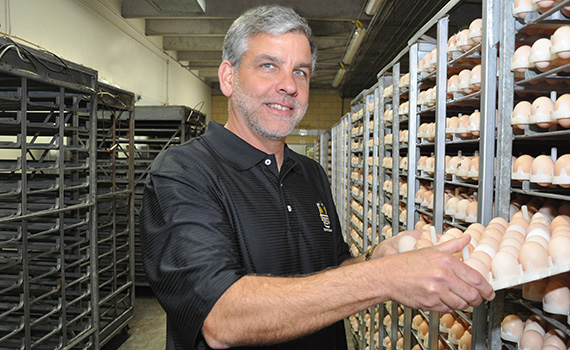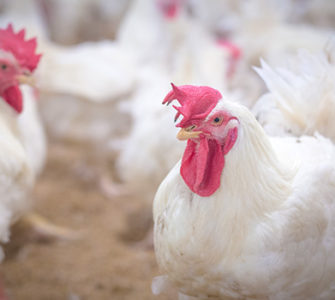Solving the mystery of gangrenous dermatitis in broilers
Gangrenous dermatitis (GD) is a serious problem for quite a few broiler producers around the US. The cause remains something of a mystery, but we are learning more about contributing factors and ways that might help prevent the disease.
It’s hard to forget the characteristic presentation of GD. First, chickens appear depressed and then often die. Their skin is purple-red with air bubbles underneath (crepitus). These are classic gross GD lesions. Birds recently dead from GD decompose rapidly but look like they’ve been dead for several hours. It’s not a pretty picture.
GD is caused by Clostridium, most commonly C. septicum and C. perfringens, along with other bacteria that are ubiquitous in both normal avian flora and healthy flock litter. And therein lies the mystery: How do these normal inhabitants induce disease? Because the bacteria that cause GD are always present, there must be something that triggers the onset of disease.
Deadly interactions
Any disease involves the interaction between the environment, host and pathogen. Wet litter, crowding, skipped feeding, accumulated mortalities not removed within 24 hours and previous flocks with GD are all predisposing factors.
For example, wet litter can create an overwhelming challenge that chickens cannot overcome: Just add water and most bacteria can grow on chicken manure. Immunosuppression with viral pathogens, especially infectious bursal disease virus and chicken anemia virus (CAV), can lower the chicken’s ability to fight off normal bacterial assaults, resulting in GD. Stress from temperature swings greater than 15° F may also weaken flocks to the point they succumb to GD.
Of course, the Clostridium spp. involved must be pathogenic and in large enough quantity to infect birds. The bacteria may be inside the bird as normal intestinal flora or outside the bird as normal litter flora. The life stage of the bacteria, whether it’s vegetative or in spore form, is also important for translocation from inside the gut lumen to abnormal circulatory distribution.
Inside-out
In my experience, GD is typically a disease associated with cold weather, most commonly late winter and early spring. More birds sick or dead due to GD are found where outside cool air enters the house, particularly before the air picks up speed and heat from the flock. Litter at this front part of tunnel-ventilated houses tends to be wetter than the rest of the house (more Clostridium spp.).
In addition, birds in the inlet area experience larger temperature swings — more immunosuppression — than birds further downstream, especially when fans bring in limited fresh air during minimal ventilation. Most of these GD birds have no external wounds to indicate any skin disruption, which may point to an “inside-out” form of GD.
Outside-in
A less common presentation of GD has been observed in southern Georgia during the fall, while temperatures are still moderately warm. Birds sick or dead from GD tend to be at fan end of the house with scabbed, scratched skin overlaying GD lesions.
Fall is also the time to pick cotton, and because many crop farmers in southern Georgia also raise chickens, the chicken houses are close to cotton fields. Cotton-picking occurs only once a year, so broilers never acclimate to the sounds of cotton harvest. As with any loud, novel sound, flocks stampede away from perceived danger. Most birds in the GD-pileup get scratched with open wounds, which are then readily available for inoculation with Clostridium in the litter. The GD in southern Georgia therefore appears to be an “outside-in” form of the disease.
A clinical case in central Texas demonstrates that good immunity is important for GD resistance. GD was rare in this area until progeny from one of the breeding flocks were diagnosed with GD at various broiler farms. The most common clinical presentation was swollen, discolored feet and shanks just prior to death. Upon further investigation, it was determined that the hen flock had received inadequate chicken anemia virus (CAV) vaccination. This might be a case of inside-out or outside-in since immunosuppression could permit GD to develop either way.
Role of ionophores
Most US broiler producers have noted that broiler flocks vaccinated for coccidiosis appear less susceptible to GD. This observation has proved true in my experience as well. Why this occurs is not clear. One theory links coccidiosis damage to increased intestinal transport of Clostridium spp. However, in my experience, more gross and microscopic coccidiosis lesions are seen in coccidiosis-vaccinated birds than in birds that receive in-feed anticoccidials. This is because the vaccine actually gives birds a low level of coccidia so they develop immunity, in contrast to in-feed anticoccidials, which limit the disease.
Another predisposing factor for GD has been convincingly documented by Don Ritter, DVM, at Mountaire Farms in Millsboro, Delaware, as well as some coccidiosis-vaccine suppliers: Feeding ionophores appears to be related to an increased incidence of GD.
One theory focuses on the direct effect of ionophores on intestinal flora. Ionophorous antibiotics are highly effective against Clostridium spp. and feeding ionophores for coccidiosis control typically stops Clostridium spp. vegetative growth — so much so that necrotic enteritis is less of an issue than when feeding chemical anticoccidials. With such antibiotic pressure, Clostridium spp. are forced into spore survival mode, which are smaller than vegetative forms. Smaller spores are more likely than growing bacteria to translocate from inside the intestinal lumen, through the intestinal wall and into the circulatory system. Circulating Clostridium spores get lodged in disrupted capillary beds; an anaerobic microenvironment is created, triggering spores to erupt into rapid vegetative growth and — voila! — GD is induced via ionophore’s antibacterial efficacy.
GD continues to challenge the US broiler producers, especially those still using ionophores to control coccidiosis. In my experience, even with coccidiosis vaccination, ionophores used as part of a “bio-shuttle” may still predispose flocks to GD.
Chemical anticoccidials seem to have no effect on Clostridium spp. Necrotis enteritis is a greater risk, but GD is unlikely since Clostridium spp. are in the vegetative state instead of the spore form.
As with any disease, the incidence of GD can be minimized by providing an optimal environment, maximizing host immunity and limiting the pathogen challenge through measures such as removing dead carcasses promptly and keeping the litter appropriately dry. On-site farm investigation after GD affects a flock typically points to an inciting cause. Learning from previous cases may help prevent GD from affecting future flocks, and this will become even more important if we have fewer remaining therapeutic options and apparently no new ones coming to market.
By Philip A. Stayer, DVM
Corporate Veterinarian
Sanderson Farms, Inc.
Posted on September 7, 2016

















